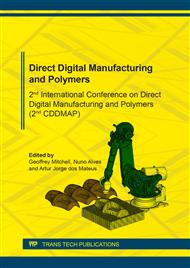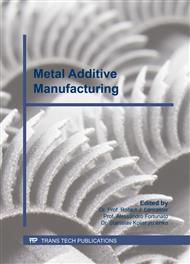[1]
V. Roblek, M. Meško, and A. Krapež, A Complex View of Industry 4.0,, SAGE Open, p.1–11, (2016).
DOI: 10.1177/2158244016653987
Google Scholar
[2]
L. Thames and D. Schaefer, Software-defined Cloud Manufacturing for Industry 4.0,, Procedia CIRP, vol. 52, p.12–17, (2016).
DOI: 10.1016/j.procir.2016.07.041
Google Scholar
[3]
Y. Lu, Industry 4.0: A survey on technologies, applications and open research issues,, J. Ind. Inf. Integr., vol. 6, p.1–10, (2017).
Google Scholar
[4]
J. Posada et al., Visual Computing as a Key Enabling Technology for Industrie 4.0 and Industrial Internet,, IEEE Comput. Graph. Appl., p.26–40, (2015).
Google Scholar
[5]
M. Schleipen, S. S. Gilani, T. Bischoff, and J. Pfrommer, OPC UA & Industrie 4.0 - Enabling Technology with High Diversity and Variability,, Procedia CIRP, vol. 57, p.315–320, (2016).
DOI: 10.1016/j.procir.2016.11.055
Google Scholar
[6]
OPC Foundation, Unified Architecture., [Online]. Available: https://opcfoundation.org/about/opc-technologies/opc-ua/. [Accessed: 28-Oct-2017].
DOI: 10.1007/978-3-540-68899-0_10
Google Scholar
[7]
J. Schmitt, T. Goldschmidt, and P. Vorst, Cloud-enabled Automation Systems using OPC UA,, Atp Ed., vol. 56, p.34–41, (2014).
DOI: 10.17560/atp.v56i07-08.2253
Google Scholar
[8]
PI North America (PROFIBUS/PROFINET International), PROFINET, Industrial Ethernet for advanced manufacturing., [Online]. Available: http://us.profinet.com/technology/profinet/. [Accessed: 28-Oct-2017].
DOI: 10.1201/b17365-29
Google Scholar
[9]
J. Y. Chen, K. C. Tai, and G. C. Chen, Application of Programmable Logic Controller to Build-up an Intelligent Industry 4.0 Platform,, Procedia CIRP, vol. 63, p.150–155, (2017).
DOI: 10.1016/j.procir.2017.03.116
Google Scholar
[10]
S. Schriegel, F. Pethig, S. Windmann, and J. Jasperneite, PROFIanalytics - die Brücke zwischen PROFINET und Cloud-basierter Prozessdatenanalyse,, Autom. 2017, Baden-bad., (2017).
DOI: 10.51202/9783181022931-7
Google Scholar
[11]
E. Negri, L. Fumagalli, and M. Macchi, A Review of the Roles of Digital Twin in CPS-based Production Systems,, Procedia Manuf., vol. 11, no. June, p.939–948, (2017).
DOI: 10.1016/j.promfg.2017.07.198
Google Scholar
[12]
J. P. Colin, Minds + Machines: Meet A Digital Twin,, 2016. [Online]. Available: https://www.ge.com/digital/industrial-internet/digital-twin. [Accessed: 18-Oct-2017].
Google Scholar
[13]
D. Chen, S. Heyer, S. Ibbotson, K. Salonitis, J. G. Steingrímsson, and S. Thiede, Direct digital manufacturing: Definition, evolution, and sustainability implications,, J. Clean. Prod., vol. 107, p.615–625, (2015).
DOI: 10.1016/j.jclepro.2015.05.009
Google Scholar
[14]
A. M. Al-Ahmari, Direct Digital Manufacturing,, J. King Saud Univ. - Eng. Sci., vol. 29, no. 3, p.203, (2017).
Google Scholar
[15]
M. Rieger, D. D. Störkle, L. Thyssen, and B. Kuhlenkötter, Robot-Based Additive Manufacturing for Flexible Die-Modelling in Incremental Sheet Forming,, Esaform, vol. 40012, (2017).
DOI: 10.1063/1.5008038
Google Scholar
[16]
K. Dröder, J. K. Heyn, R. Gerbers, B. Wonnenberg, and F. Dietrich, Partial Additive Manufacturing: Experiments and Prospects with Regard to Large Series Production,, Procedia CIRP, vol. 55, p.122–127, (2016).
DOI: 10.1016/j.procir.2016.09.008
Google Scholar
[17]
S. Ambriz et al., Material handling and registration for an additive manufacturing-based hybrid system,, J. Manuf. Syst., vol. 45, p.17–27, (2017).
Google Scholar
[18]
D. Schaefer, L. Thames, D. Wu, S. Yim, and D. Rosen, Distributed Collaborative Design and Manufacture in the Cloud—Motivation, Infrastructure, and Education,, ASEE 2012 Annu. Conf. Expo., (2012).
DOI: 10.18260/1-2--21230
Google Scholar
[19]
J. Domingues, T. Marques, A. Mateus, P. Carreira, and C. Malça, An Additive Manufacturing Solution to Produce Big Green Parts from Tires and Recycled Plastics,, Procedia Manuf., vol. 12, no. December 2016, p.242–248, (2017).
DOI: 10.1016/j.promfg.2017.08.028
Google Scholar
[20]
Yaskwa Europe, MOTOMAN FS100 Industrial Robot Controller." [Online]. Available: https://www.yaskawa.eu.com/index.php,eID=dumpFile&t=f&f=13337&token=1a3aae4fef6fd8b66cfb30763545b1e3214c7f91. [Accessed: 09-Nov-2017].
Google Scholar



